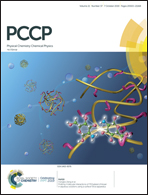Coinage metal dimers as the noncovalent interaction acceptors: study of the σ-lump interactions
Abstract
The ability of group 11 coinage metal dimers M2 (M = Cu, Ag, Au) to favorably interact with different electron acceptors XCN (X = H, F, Cl, Br) was evaluated with the M06-L functional and the aug-cc-pVDZ basis sets (aug-cc-pVDZ-pp basis sets were used for copper, silver, and gold atoms). The metal dimers M2 (M = Cu, Ag, Au) have negative regions of electrostatic potential (ESP) in the middle of the M–M bond, namely the σ-lumps. The positive ESP outside the X atom along the extension of the X–C bond in XCN (X = H, F, Cl, Br) could interact with the σ-lump of metal dimers to form the σ-lump interactions. When M remains unchanged, the σ-lump interactions between M2 (M = Cu, Ag, Au) and XCN (X = F, Cl, Br) increase gradually in the order of F, Cl and Br. The electrostatic interactions are the dominant attractive interactions in the M2⋯XCN (X = F, Cl, Br) halogen-bonded interactions. The orbital interactions contribute more than the electrostatic interactions in the M2⋯HCN hydrogen-bonded interactions. Molecular graphs after orbital separation show that the π orbitals contribute the most to the σ-lump interactions; the σ and δ orbitals also have some contributions. Charge transfer occurs in the formation of the σ-lump interactions, mainly from the M–M bonding orbital of metal dimers to the X–C anti-bonding orbital. The M2⋯BrCN (M = Cu, Ag, Au) series complexes possess the largest charge transfer from donor to acceptor orbitals.

- This article is part of the themed collection: 1st International Conference on Noncovalent Interactions


 Please wait while we load your content...
Please wait while we load your content...